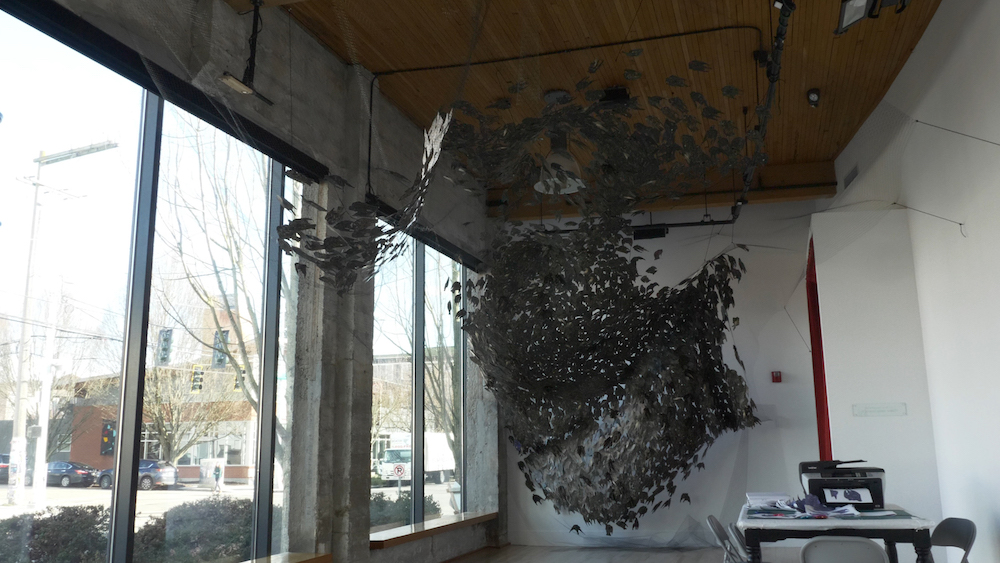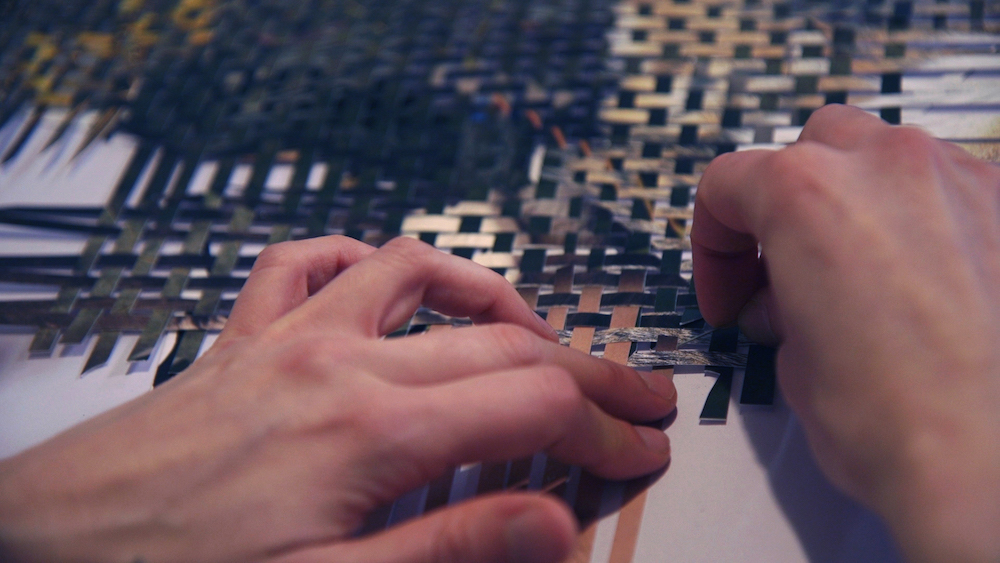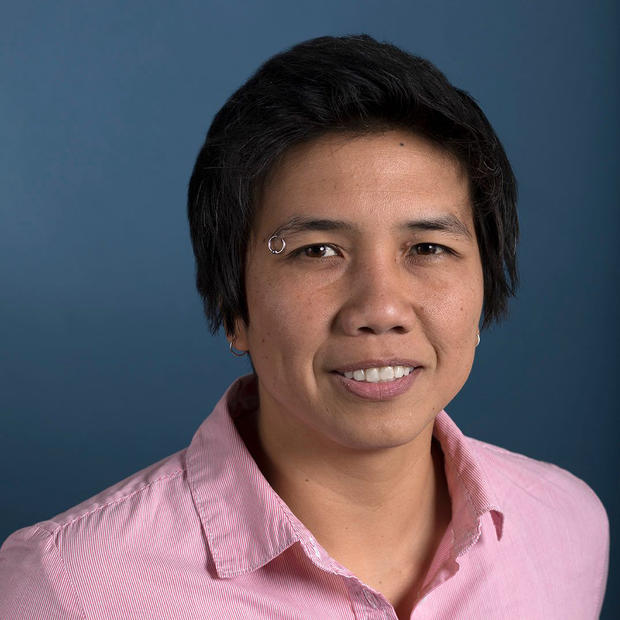In 1890, amateur ornithologist Eugene Schieffelin thought it would be marvelous to import all the birds mentioned in Shakespeare to the United States. So he did, under the auspices of the American Acclimitization Society, a voguish New York City group dedicated to introducing European flora and fauna to America for reasons both aesthetic and utilitarian. Most of the Shakespearean birds (nightingales, skylarks) died. But the 60 European starlings released in Central Park took to the place, and are considered the progenitors of the 200 million starlings that now swarm and swoop across Canada, the U.S. and Mexico.
When it comes to invasive species, starlings are superstars. That’s why Seattle artist Markel Uriu chose them as the centerpiece in her new solo show, An Object Lesson, at Hedreen Gallery on the Seattle University campus. Uriu’s multimedia work explores the concept of invasive species — whether introduced deliberately by human hands or inadvertently, as when species hitch a ride on human transportation — and the implications of, as she puts it, “how our culture manifests on the landscape.”
A week before her show opens, Uriu’s personal landscape (in the form of her car) has been infested with 5,000 paper starling cutouts. But like Schieffelin, she brought this upon herself. These initial starlings will reproduce like European rabbits (also invasive), as Uriu needs some 12,000 starling simulacra for her plan to invade the gallery with a murmuration (the mellifluous moniker for a flock of starlings).
“I’m thinking about the consequences of … a whim,” Uriu says. “You have a whole new species integrated into the North American ecosystem, all because someone loved Shakespeare and wanted to enrich the landscape with that culture. I’m trying to depict the weight of that.”
How do you make a murmuration? Uriu started with 60 dead starlings — or rather, starling skins. “Oh, no, I couldn’t afford whole birds,” she says, as if that’s obvious. So where does one purchase a large number of starling pelts, with heads and feathers attached? “Fly fishing websites,” she says. “Doing sculpture and installation really expands my world,” Uriu adds, laughing. “I know nothing about fly fishing but they must go through a lot of birds. They have whole pages of just bird skins.”
In her tiny Georgetown studio, jets roaring low overhead, Uriu picks up a cardboard box from a shelf, next to a pile of rabbit pelts from a previous project. She opens it to reveal a soft but grisly sight, 60 black starlings, or more like starling casings. They look almost alive, nesting.
For the installation, she scanned each of them on a flatbed scanner, then programmed a die-cut machine to carve out the 60 slightly varied body shapes. Once at the Hedreen, she began pinning the paper cutouts to a black fishnet she had hung from the ceiling in a cloudlike shape that mimics a mumuration’s amoebic form. When finished, she’ll have added the actual starling skins to the paper swarm, the effect of which is that the fake birds have somehow spawned real ones.
Uriu, 30, is a deep researcher who thinks in layered concepts — but she’s not without a sense of humor about the more peculiar aspects of her art. She laughs remembering the shocked security guard who encountered her midstarling-scan one night, during her recent term as Amazon Artist in Residence. A graduate of Whitman College, she moved to Seattle five years ago after a stint in New York City. Talking about her work, Uriu gets tangled up in tangents about the remarkable history she’s uncovered, a new theory she just read about, and the connections she’s making between environmental concerns, globalism, colonialism, technology and her own experience as a “yonsei,” a fourth-generation Japanese American.

She says the hands-on quality of her work is therapeutic, as it helps her approach a meditative state via countless repetitions (copying, cutting, stitching). Repeated small actions register the passage of time and reflect what she calls “the power that comes from being able to endure.” Previous work has involved training Himalayan blackberries, sewing together the papery leaves of Lunaria (“money”) plants and creating a wolf pelt out of living moss.
In addition to the murmuration that’s part of An Object Lesson, Uriu has woven several large-scale paper “maps,” which depict the overlap of invasive species found in the Pacific Northwest. With the help of a University of Washington ecologist willing to lend a few frozen specimens, she turned again to her trusty scanner to replicate specific plants and animals. “Red swamp crayfish, a rainbow trout, largemouth bass, Chinese mystery snails, zebra mussels, American bullfrog,” she lists. “Plus plants I sourced myself — knotweed, mallow, dandelion.” Uriu also scanned her own belly button (“a nod to our own reproductive habits,” she says), and her partner’s house cat, tricked onto the glass surface by placing the scanner inside an open box.

After printing out high-quality scans, Uriu sliced the paper into thin strips. With a nod to scientific classification, she pinned and framed one copy of each “dissected” species scan as if it were an insect specimen. She then commenced weaving copies of all the scans together in the style of construction-paper placemats made by generations of kids. But in this case, the results are far more organic and resonant. From afar, they appear to be woven wall hangings in the form of abstract landscapes or loosely lined maps, whose subtle colors shift gradually from brown to green to yellow and back. Only up close do individual species become clear, in recognizable bits of hair, shell and skin. The unwoven edges seem ready to accept a new invader into the fold.
“Because we’re so interconnected, we’ve managed to create a globally homogenous ecosystem,” Uriu explains. “You can go around the world and see the same species you could see here. So in that way we’re creating a second Pangea,” she says, referring to the supercontinent that existed before land masses broke off into separate continents. She also says the weavings can be viewed as a “physical manifestation of the internet,” where “a lot of ideas are exchanged, and certain ones almost arbitrarily take off and integrate themselves around the globe.”
Uriu notes that, ironically, some of the worst ideas taking root globally right now have to do with what — and who — is considered invasive.
“Part of what’s also interesting to me about invasive species is the fear of foreignness,” she says. She shares a story about her paternal grandmother, who when she was 18 years old, was sent to the Japanese incarceration camp in Poston, Arizona. “She had been in a car accident, and was in a full-body cast on Pearl Harbor Day. They stopped treating her and sent her straight from the hospital on crutches to Poston,” Uriu says. “So in my own family history, there’s been fear of foreignness, of something that doesn’t belong, and that idea continues to be perpetuated.”
Back at the Hedreen, she climbs a red ladder and pins starling after startling onto the high net. She wants to make clear her exhibit isn’t trying to convince people of anything.
“The subject of invasive species is really complicated,” Uriu says. Lately she’s been reading about how some species wouldn’t be invasive were it not for human actions (such as extreme water usage) that transform places into perfect biomes for nonnative species. “In reality, we’re scapegoating them for issues we’ve created ourselves,” she says.
She climbs down and steps back to assess the growing murmuration, it’s depth, darkness and direction, the effect of her actions on the landscape.
Crosscut arts coverage is made possible with support from Shari D. Behnke.
Get the latest in local arts and culture
This weekly newsletter brings arts news and cultural events straight to your inbox.



